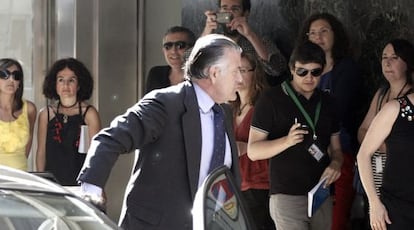Luis Bárcenas becomes latest high-profile inmate at Soto del Real
Ex-PP treasurer will be sharing a 10-by-10-meter cell and will have to perform chores

The first to arrive was Gerardo Díaz Ferrán; then came Ángel de Cabo, Miguel Blesa, and now Luis Bárcenas. Last week, the former Popular Party treasurer became the latest in a line of high-profile suspects charged with financial crimes to enter Madrid's Soto del Real prison.
The facility, built in 1995 to replace the dilapidated Carabanchel prison, has in recent months become the holding jail for some of Spain's most notorious political and financial figures. On December 6, Díaz Ferrán was ordered held there as a judge continues his investigation into whether the former president of Spain's largest businessmen's confederation, the CEOE, tried to conceal money in order to avoid paying some 400 million euros in debts he owed after his Viajes Marsans travel agency went into bankruptcy.
His alleged front men, who prosecutors say helped him, were Valencia businessman Ángel de Cabo and his assistant Iván Losada, both of whom are also being held at Soto del Real in lieu of bail. A judge set bail for Díaz Ferrán at 30 million euros but later reduced it to five million. De Cabo's bail was also reduced, from 50 million euros to three million.
Blesa, the former chairman of savings bank Caja Madrid, posted a 2.5-million-euro bail in May, a day after a judge ordered him to be held in connection with the Díaz Ferrán case. But he was sent back to prison in early June when the same judge, Elpido José Silva, found probable cause against him for alleged irregularities in the purchase of City National Bank of Florida. He was freed again on June 20 after a Madrid regional High Court ordered his release.
The facility has become the holding jail for Spain's most notorious political and financial figures
But the Bárcenas case is different. The target of several tax-evasion and money-laundering investigations, the former PP bigwig was sent to Soto del Real on Thursday after a High Court judge ruled that he was a flight risk and had been tampering with evidence. The 57-year-old's finances, including the origins of a 47-million-euro fortune stashed away in Swiss bank accounts, are under investigation.
Bárcenas arrived at Soto del Real as an ordinary inmate and was treated as such. Prison officials took his mugshot, fingerprints and confiscated all his valuables. The disgraced former PP treasurer also underwent medical and psychological evaluations.
Social workers evaluate all inmates to set a security classification and determine their custody level. Bárcenas, Blesa, Díaz Ferrán, De Cabo and Losada all lack criminal records. As such, they will be housed with first-time offenders. Their movements are relatively unrestricted in their prison modules, but they will be tasked with certain chores, such as sweeping and mopping floors.
Bárcenas will be given 10 five-minute phone calls per week. He will have the right to deposit up to 100 euros every seven days in his inmate account to cover any purchases he needs to make, and can receive a visitor once a week for 40 minutes.
There are 14 modules with 72 cells at Soto del Real. Each building has a small gym, a common room, a yard, a dining room, a television room and classrooms.
Depending on the inmate's classification, prisoners are either housed alone or share one of the 10-by-10-meter cells with another person. Lockup is for 12 hours, and at 8am the doors open so that inmates can clean up their cells. Breakfast is served at 8.30am. In the morning, inmates can spend their time in the common room or attend classes. At 1.30pm lunch is served and afterwards the inmates go back to their cells for an afternoon siesta . Dinner is served at 8pm but inmates are once again locked up for the night at 9.30pm.
Tu suscripción se está usando en otro dispositivo
¿Quieres añadir otro usuario a tu suscripción?
Si continúas leyendo en este dispositivo, no se podrá leer en el otro.
FlechaTu suscripción se está usando en otro dispositivo y solo puedes acceder a EL PAÍS desde un dispositivo a la vez.
Si quieres compartir tu cuenta, cambia tu suscripción a la modalidad Premium, así podrás añadir otro usuario. Cada uno accederá con su propia cuenta de email, lo que os permitirá personalizar vuestra experiencia en EL PAÍS.
¿Tienes una suscripción de empresa? Accede aquí para contratar más cuentas.
En el caso de no saber quién está usando tu cuenta, te recomendamos cambiar tu contraseña aquí.
Si decides continuar compartiendo tu cuenta, este mensaje se mostrará en tu dispositivo y en el de la otra persona que está usando tu cuenta de forma indefinida, afectando a tu experiencia de lectura. Puedes consultar aquí los términos y condiciones de la suscripción digital.
Últimas noticias
Half of Scotland is in the hands of 420 property owners
From digital curfews to blocking apps: How technology experts protect their children online
Why the price of coffee has skyrocketed: from Brazilian plantations to specialty coffee houses
Confined to a Cuban hospital: When electricity is a matter of life or death
Most viewed
- Why we lost the habit of sleeping in two segments and how that changed our sense of time
- Trump’s obsession with putting his name on everything is unprecedented in the United States
- Charles Dubouloz, mountaineering star, retires at 36 with a farewell tour inspired by Walter Bonatti
- The Florida Keys tourist paradise is besieged by immigration agents: ‘We’ve never seen anything like this’
- Living in a motorhome due to soaring housing prices in Madrid: ‘I got used to it quickly, but I don’t idealize it’








































